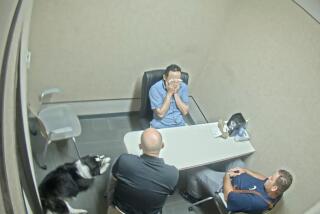Tried for Murder, He Can’t Speak, Hear
- Share via
MOBILE, Ala. — When the jury decided his fate here Wednesday, Jimmy Green took the verdict in silence.
It was the same reaction he had shown to the murder charge that brought him here and to everything else that happened during his trial, because for Green, a deaf mute who can neither read nor write nor understand sign language, silence is a state of nature.
The 44-year-old from nearby Citronelle was tried for the murder of Willia (Aunt Roxy) Wesley, that rural hamlet’s 92-year-old bootlegger and moneylender.
Green’s trial went forward despite the fact that the judge, prosecutor and defense attorney all agreed that the poverty-stricken man had not understood a word of the proceedings against him.
Earlier in the three-day trial Judge Douglas Johnstone of Mobile County Circuit Court rejected out of hand a defense argument that the charges against Green ought to have been dismissed because he was unable to cooperate in his own defense. “I did not expect anybody would be able to communicate with him,” the judge said, “but I’m not stopping this trial.”
It took the jury less than an hour to acquit Green, a decision that appeared, at least in part, to have been based on defense attorney Richard R. Williams’ decision to put his client on the stand.
Although it lasted less than a minute, it was a dramatic and emotionally wrenching demonstration of the accused man’s nearly total isolation: When asked his name, Green made unintelligible sounds.
“Do you understand why you’re here?” Williams asked.
Green made motions with his hands over both ears and shook his head.
Several jurors wore pained expressions and shifted uncomfortably during the short time Green occupied the witness stand.
According to his father, a gaunt man with a silver crown of hair and beard, Green thought he was “in school” as the trial went on. The arresting officer, asked whether Green understood his Miranda rights against self-incrimination, replied: “I don’t think he did.”
The trial attracted little notice outside of Mobile, a port city on the southern coast of Alabama, and even here, it won front-page display in the local newspaper only after editors learned a national cable news network intended to air the story. Before then, it had run in the local news section of the paper.
Yet, Green’s attorney maintains, the trial raised fundamental questions about a defendant’s constitutional rights to due process in a court of law.
“You have someone here on trial who has no idea of what’s going on, who isn’t able to testify on his behalf or even tell anyone whether he wants to testify or not,” said Williams.
On Monday, the first day of Green’s trial in connection with the stabbing death, a court-approved sign language interpreter gave up on him.
“He is just mimicking the signs I’m making,” said the interpreter, Marie Grove.
Wesley was found stabbed five times in the back and severely beaten in her Citronelle home in a mostly black section of town known as “The Quarters” on Nov. 16, 1985. Both the victim and defendant are black.
Citronelle residents who have testified for both the state and defense portrayed the woman as a well-known community figure who sold bootleg whiskey for $3.50 a half-pint or 50 cents a shot and who frequently loaned money interest-free to needy residents.
The evidence against Green was largely circumstantial. According to testimony, Green was seen in the victim’s yard only minutes before her body was discovered. Forensic tests also disclosed that the blood type found on Green’s pants and one of his hands matched Wesley’s.
In addition, a cigarette found at the crime scene was of the same brand Green allegedly had bummed from a friend less than two hours before the murder was discovered.
Joe (Buzz) Jordan, assistant state district attorney for Mobile County, contended the circumstantial evidence was sufficient for the jury to rule on the charges against Green.
“Due to the brutality of the murder and the facts that link him to it--specifically, the blood evidence--you have to try the case,” he said in an interview. “His condition doesn’t exempt him from having the case tried.”
Green, a thin, wiry man with melancholy dark eyes and black hair and mustache lightly flecked with gray, communicates with signs only people close to him know. For example, he holds two fingers to his lips for a cigarette. If he needs a ride home, he pulls his father’s phone number from his billfold and gives it to someone to call.
Green’s attorney contended in court that the bloodstains on Green’s clothing could be explained if Green went in the house after the murder had been committed and attempted to pick up Wesley’s body, which was slumped on the floor by her bed.
Williams also argued, in his closing statement Wednesday, that marks and abrasions on the victim’s body suggest that she was tortured before she was stabbed to death and that more than one person was involved in the crime.
More to Read
Sign up for Essential California
The most important California stories and recommendations in your inbox every morning.
You may occasionally receive promotional content from the Los Angeles Times.










